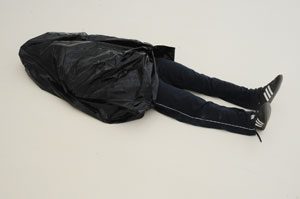Gregor Schneider | Haus u r project
Videos, sculpture and photography from the Haus u r project

The works on show in the exhibition are all derived from one particular site of origin: Haus u r. This is the name that Gregor Schneider has given to a continuous project he began in the mid-1980s and worked on for approximately 20 years, during which he has completely rebuilt the interior structure of a family home, an empty building in Rheydt-Mönchengladbach, Germany. While working on the house (whether this work entailed more wrecking or building is not clear), Schneider has erased its grid, eliminated its original length and breadth axes, and turned it into a labyrinth, an enclave: rooms were built within rooms, walls were placed in front of walls, levels were added and removed – resisting the pretensions to permanence of all these elements, and architecture in general. It is impossible to decide unequivocally what the ontological status of the house in Rheydt-Mönchengladbach is, or what sort of relations between art and life is being proposed by it. In Schneider’s work, in contrast to the Dadaist approach to eliminating the differences between life and art, there is a marked expressiveness. Haus u r contains “ordinary” rooms – Corridor, Vestibule, Staircase, Bedroom, Kitchen, Closet, Bathroom, Coffee Room, Studio – that anchor petit-bourgeois banality in menacing aspects of impropriety. There are also rooms laden with overt perversion, like the Completely Insulated Guest Room, the Spinning Guest Room, or the Cabinet of Mirrors. Besides these, the house contains hiding places or nether spaces, like Cellar or The Last Hole. Schneider is interested not only in the rooms themselves, with all the complex typology they entail, but also in the holes, the shafts, the abysses, the recesses produced in the course of his work on the house, in which every wall is at one and the same time an internal and an external boundary. In these gaps, spaces have been created that remain beyond the capacity of imaging, of language, of mapping, of knowing. In the first of the two catalogues accompanying this exhibition, Friedhelm Mennekes describes the rooms in the house as “forms of existence that refuse direct perception,” a disturbance to our prior knowledge about the world and a movement between one conceptual status and another.